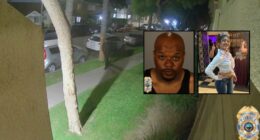The Police believed ‘beyond doubt’ that the Loch Ness Monster existed and tried to protect it from a harpoon-wielding mob, an unearthed report has revealed.
Documents from 1938 – five years after the first photo purporting to show the rumoured beast was taken – detail efforts by the authorities to safeguard Nessie.
According to a letter written by Invernessshire Constabulary chief constable William Fraser, two individuals were attempting to capture Nessie ‘dead or alive’ using a harpoon gun.
He added: ‘That there is some strange creature in Loch Ness seems now beyond doubt, but that the Police have any power to protect it is very doubtful.’
The officer went on to detail how he warned that the beast should be left alone.
The documents were uncovered by Kenny Welsh, a member of The Loch Ness Centre, in Drumnadrochit, Scotland.
They pile further intrigue onto what has been a global obsession for decades.
The first photo purporting to show Nessie was taken in November 1933, by Scottish man Hugh Gray.

The Police believed ‘beyond doubt’ that the Loch Ness Monster existed and tried to protect it from a harpoon-wielding mob, an unearthed report has revealed

On a sunny day in November 1933, Scottish man Hugh Gray took a picture that would spark a global obsession. He later described what he saw in Loch Ness, near Inverness, as an ‘object of considerable dimensions’
He later described what he saw in Loch Ness, near Inverness, as an ‘object of considerable dimensions’.
Gray’s photo came after another man, Loch Ness water bailiff and part-time journalist Alex Campbell, reported on the sighting of an ‘enormous creature with the body of a whale rolling in the water in the loch’ earlier in 1933.
Fraser’s letter read: ‘It has now come to my notice that a Mr Peter Kent and Miss Marion Stirling, both of London, are determined to catch the Monster dead or alive.
‘Mr Peter Kent visited Fort Augustus on Friday, 12 August and was seen there by my Officer stationed at Fort Augustus.
‘To whom he stated that he was having a special harpoon gun made and that he was to return with some twenty experienced men on the 22 of August for the purpose of hunting the Monster down.
‘That there is some strange creature in Loch Ness seems now beyond doubt, but that the Police have any power to protect it is very doubtful.
‘I have, however, caused Mr Peter Kent to be warned of the desirability of having the creature left alone, but whether my warning will have the desired effect or not remains to be seen.’

The documents were uncovered by Kenny Welsh, a member of The Loch Ness Centre, in Drumnadrochit, Scotland

In 1934, a picture taken by London physician Robert Kenneth Wilson captured the world’s attention. It showed what appeared to be a beast rearing its head out of the water. It was later exposed as a hoax
Mr Welsh discovered the fascinating police report while doing some research.
‘I love the 1938 police report – it’s a piece of the jigsaw that makes up the story of Loch Ness and our elusive monster,’ he told news website What’s The Jam.
‘It offers a rare glimpse into how even the police believed there might be something in the water.’
Nagina Ishaq, general manager of The Loch Ness Centre, said: ‘It’s fascinating to see the historical local support for Nessie’s protection from potential poachers.
‘The dedication to ensuring its safety is something that resonates strongly with us here at the Centre.

Lachlan Stuart’s photograph in 1951 photo showed three humps poking out of the surface of the loch
‘As we continue our search, we are committed to doing so in a way that is non-invasive and respectful of the creature and its environment.
‘With advancements in technology, such as ROVs, we aim to carry out the search for Nessie in the safest and most careful way possible, ensuring that future generations can experience the wonder of Loch Ness for years to come.’
Alan McKenna, of Loch Ness Exploration, added: ‘The 1938 police report is a rare moment where the mystery of Loch Ness crosses into official record.
‘It reminds us that even authorities couldn’t ignore what people claimed to see.’
The Nessie mystery could date as far back as 565AD, when Irish missionary Saint Columba was recorded to have encountered a strange water monster in the River Ness, which feeds the famous loch.
According to his centuries-old biography, the water beast had slain one man and attacked another when it fled in terror after Saint Columba made the sign of the cross and ordered it back.









